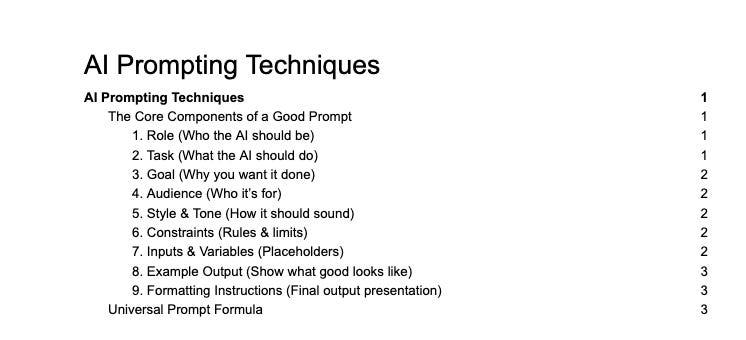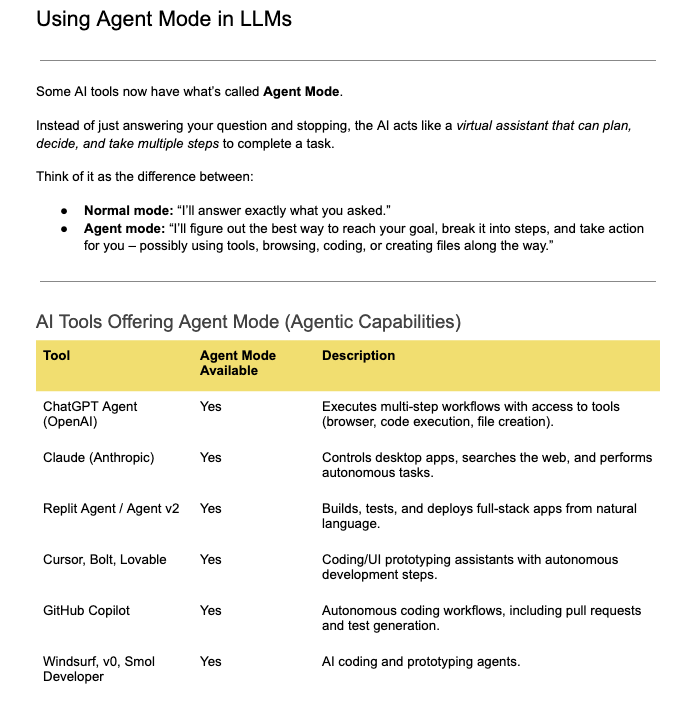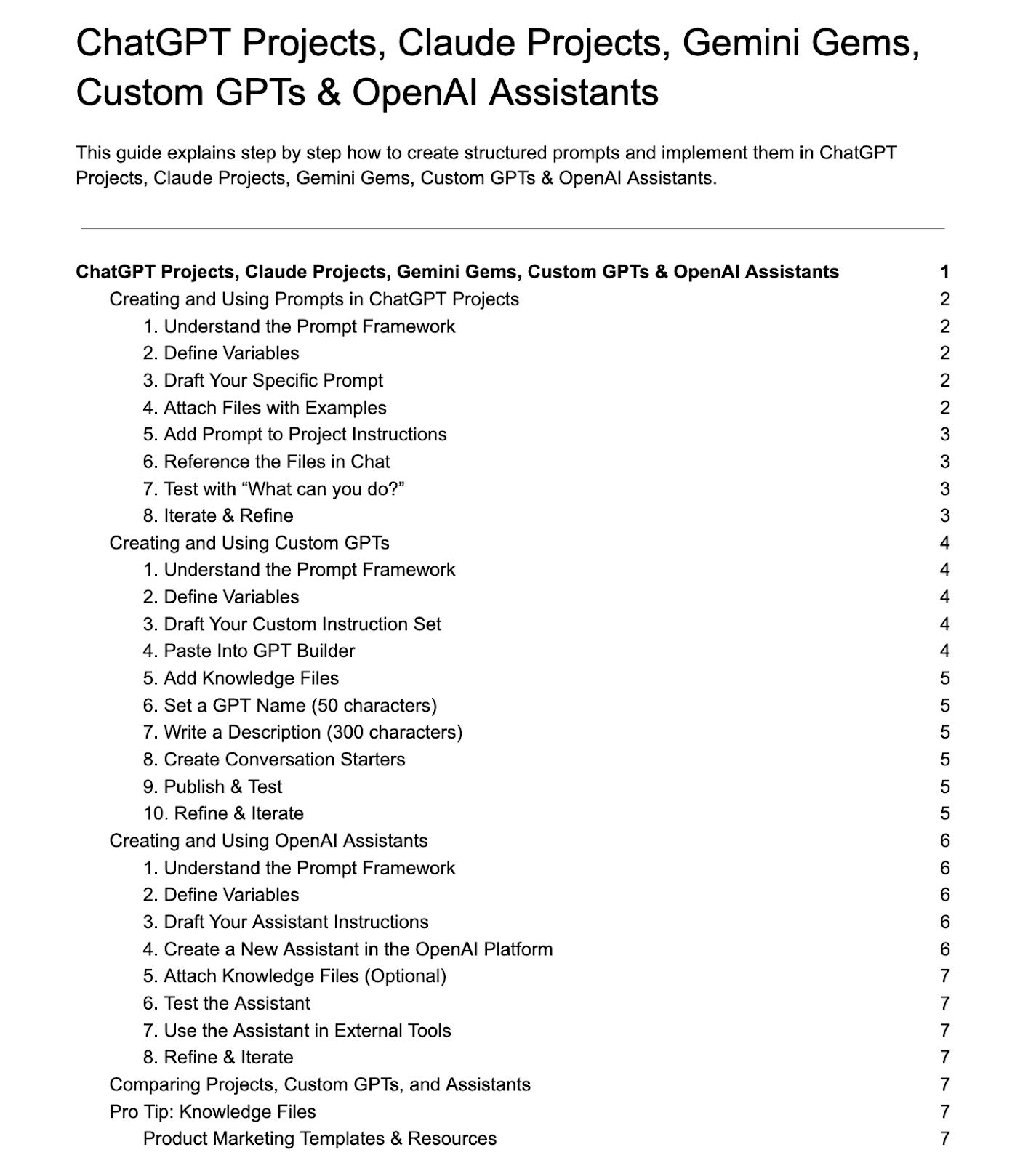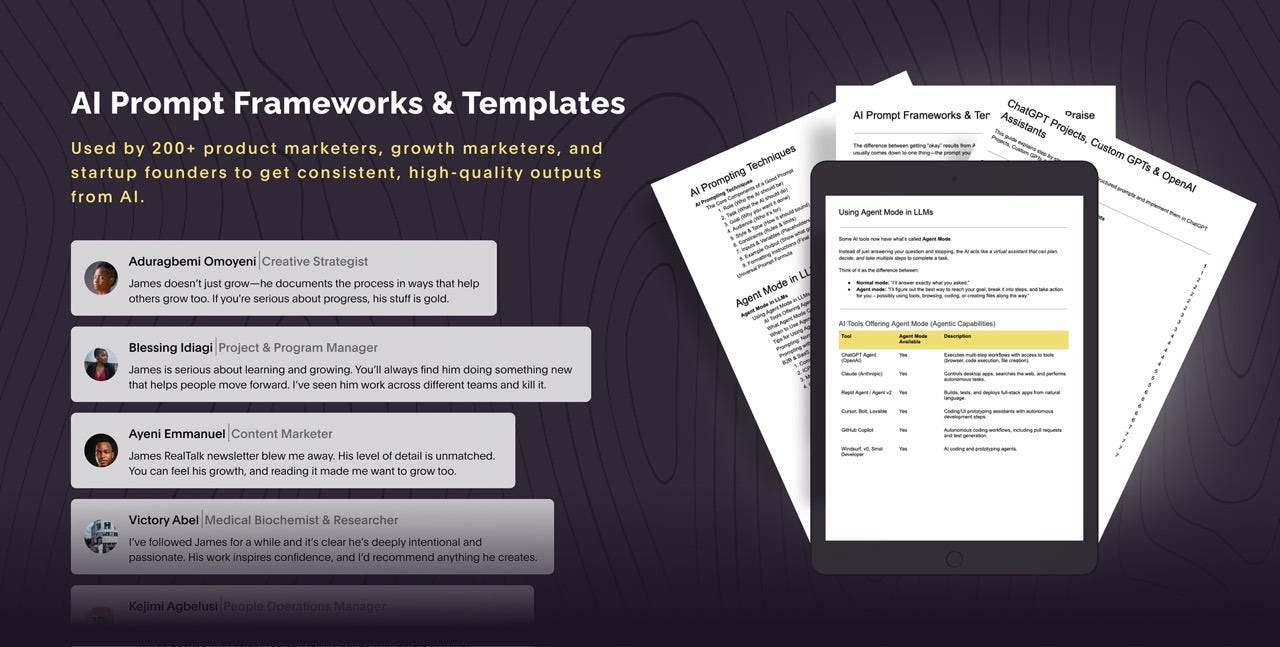MIA #14: Frameworks to Make AI Your Best Marketing Intern (+Template)
Prompt engineering frameworks and 40+ templates to produce consistent, high-quality outputs from ChatGPT, Gemini, Claude, & others for GTM workflows.
Thanks for reading MIA—everything you need to put marketing into action—templates, frameworks, community, data, insights, case studies, ideas, and martech/GTM tools. Share it with your network! ~James
The difference between getting “okay” results from AI and getting the work you’re actually proud to use usually comes down to one thing—the prompt you give it.
AI isn’t lazy; it mirrors your clarity. Without direction, even the smartest model behaves like that new intern who’s capable but wandering.
Over the past few months, I’ve been testing ways to fix that. I’ve built more than 40 AI workflows powered by prompt frameworks that now sit at the center of how I work. They help me automate real marketing tasks, including positioning, copy, GTM planning, and even competitor research, without losing tone or intent.
Everything I’ve learned lives inside one system: the AI Prompt Library, a complete playbook that marketers, founders, and operators can use to brief AI like a teammate, and not a tool.
In this issue, I’ll share the frameworks behind it: the 9-Step Prompt Framework, how Agent Mode changes the game, and why Prompt Variables make scaling effortless.
And if you’d rather see it in action, join the live webinar where I’ll build real workflows step-by-step. Attendees get the Free MIA Community Version of the AI Prompt Library to follow along.
👉🏽 Join the Marketing In Action WhatsApp Community, where MIA Newsletter subscribers network, and gossip (what’s trending).
Why your AI outputs sound generic
Most marketers think they have an “AI problem.” What they actually have is a briefing (prompting) problem.
AI can’t guess your context; it only reflects it. For instance, if your prompt says, “Write a blog post about our product,” you’ve given it zero insight into audience, tone, or goals. That’s why most outputs sound like bland press releases.
A good prompt has five elements:
Clarity: Your request must be explicit and outcome-oriented.
Context: AI needs to know who you are, what you do, and why you’re asking.
Constraints: Give limits like word count, tone, style, audience, and examples.
Continuity: Tie your prompt to previous steps or documents so AI builds on existing logic.
Consistency: Use repeatable formats and variables.
If your prompt lacks any of these five elements, it doesn’t matter how good your model is; your output will drift. The best AI workflows start by turning messy requests into structured communication.
The 9-Step Prompt Framework
Once you understand the anatomy of a good prompt, you can apply this Universal Prompt Formula (a structured approach that forces clarity and repeatability).
It works like this:
Role: Who the AI should act as.
“Act as a senior B2B SaaS product marketer specializing in conversion copywriting.”Task: What it should do, step-by-step.
“Write a 500-word blog post with a hook, three insights, and a call-to-action.”Goal: Why you want it done.
“The goal is to educate SaaS founders about using AI workflows for marketing.”Audience: Who it’s speaking to.
“Early-stage B2B SaaS founders and growth operators.”Style & Tone: How it should sound.
“Conversational, analytical, and story-driven, like Marketing In Action.”Constraints: What to avoid or limit.
“No generic phrasing, avoid ‘next-gen,’ keep it under 600 words.”Inputs & Variables: What changes each time.
[product name], [feature], [benefit], [target persona], [goal]Example Output: Show what “good” looks like.
Formatting: Tell it how to present results.
“Use markdown headers and short paragraphs.”
Think of this as your blueprint for every great prompt. Each component tells the AI exactly what it needs to do, why it matters, and how it should think.
The full AI Prompt Library goes for a small price, but I pulled out a few pages from the 40+ templates and workflows so you don’t miss out completely. Consider it my way of saying thanks for reading—you can download it here for free.
Agent Mode: when AI starts to think like a strategist
Modern models like ChatGPT, Gemini, GitHub Copilot, Lovable, Cursor, Bolt, Windsurf, V0, Smol Developer, Replit Agent, and Claude can now run in Agent Mode, meaning they can plan, execute, and iterate across multiple steps.
That means AI doesn’t just write; it can::
Research competitors
Build messaging frameworks
Generate and rank ideas
Produce and format outputs automatically
Some of my favorite use cases from the AI Prompt Library include:
Competitive Analysis Agent: Benchmarks your product against competitors.
ICP Persona Agent: Builds detailed audience profiles and pain points.
GTM Content Agent: Produces a LinkedIn post, blog, and email sequence from one input.
Outbound Stack Research Agent: Finds and compares martech tools for campaigns.
Agent Mode turns AI from a note-taker into a strategist, the kind of teammate who remembers context and acts on it.
Prompt variables: the secret to reusable prompts
Most people write a new prompt every time they start a project, which is unnecessary. Prompt Variables make your prompts modular, allowing you to reuse the same framework for different products, audiences, or campaigns.
Variables are placeholders inside prompts, like [product], [feature], [audience], [benefit], [category]. They make prompts modular and scalable.
For instance:
“Act as a senior [industry] marketer. Create a [content type] for [target audience] highlighting [key benefit] of [product name]. Goal: [objective].”
Instead of writing ten prompts for ten products, you just swap the variables and the system adapts instantly.
What workflow should I build live in the webinar?
ChatGPT Projects, Claude Projects, Gemini Gems & Custom GPTs
The secret to scaling AI isn’t more tools, it’s integration. Once your prompts are structured, you can plug them into AI platforms that act as workspaces or operators.
I use this exact framework inside:
ChatGPT/Claude Projects: Create dedicated workspaces where all prompts, context, and results are stored in one project, perfect for long-term campaigns, and shareable with your team.
Gemini Gems: Assign structured prompt “gems” that you can reuse across chats. Works like ChatGPT projects.
Custom GPTs: Build private or public versions of ChatGPT trained on your product, website, or documentation, so it knows your context automatically.
OpenAI Assistants API: Connect your prompt systems to tools like Zapier, Notion, or Airtable for full automation (idea → generation → storage → execution).
This is how AI stops being a “cool assistant” and becomes an operator inside your marketing engine.
I’ll be hosting a live webinar this November where I’ll show you how to build real AI workflows using these same frameworks and templates, including how I’ve built 40+ Custom GPTs, Claude Projects, and Gemini workflows.
Don’t miss it. Register here.
Prompting is the new marketing literacy
Forget “learning AI.” The real skill is briefing it properly. AI isn’t replacing marketers; it’s promoting the ones who can translate strategy into structure.
Within five years, prompting will be as normal as writing a campaign brief or optimizing a landing page, and the marketers who’ll thrive won’t be the loudest; they’ll be the most systematic.
Start building your library today.
📣 Share this with a founder or marketer on Twitter | LinkedIn | WhatsApp. It takes me 20 hours to write this. Sharing will only take 20 seconds.
🧩 Get the full AI prompt library.
Get access to 40+ Custom GPTs and AI-assisted marketing systems that’ll help you get better results, every single time. Get access here.
TL: DR
Get a PDF summary of this article here.
AI isn’t creative magic—it’s structured delegation.
The 9-Step Prompt Framework helps you brief AI like a senior marketer.
Every prompt should define role, task, audience, goal, and format.
Turn prompts into reusable frameworks with variables.
Use templates for positioning, messaging, GTM, and copywriting.
Operationalize your prompt systems in ChatGPT, Notion, and Zapier.
Build “Custom GPTs” that behave like trained interns.
A good prompt balances clarity, context, constraints, continuity, and consistency.
AI doesn’t replace marketers—it multiplies the good ones.
Join the live webinar to see how I build 40+ AI workflows.
Was this helpful? Hit that ❤️ and let me know your thoughts in the comments! Want to see more of this content? Restack this post (if you’re on Substack) and share it with your friends!
You might find these interesting:
AI Prompt Frameworks & Templates for Marketers – Free MIA Community Version
MIA Webinar – AI Prompt Frameworks & Templates for Marketers
Open AI Academy’s ChatGPT for Marketing – Learn ChatGPT use cases and prompts for marketing teams.
Product & Partner Recommendations:
Titaja – TITAJA is an on-demand subscription-based product marketing service (PMaaS) helping product-led, SaaS, and B2B companies unlock growth at every stage of the customer lifecycle, with GTM strategy, positioning, messaging, and demand generation.
James Praise – I help founders of B2B SaaS startups drive product marketing strategy and execution across every stage—positioning, messaging, landing pages, GTM, product launches, lifecycle programs, and growth experiments.
Clay – Clay combines 50+ data providers, real-time scraping, AI, and outbound workflows, so you can send automated, 1-1 personalized campaigns (and book more meetings than your sales team).
Testimonial – Testimonial makes it easy to collect text and video testimonials from your customers in minutes, with no need for a developer or website hosting.
Riverside – Riverside makes it easy to record remote podcasts and video interviews that look and sound like they were recorded in a million-dollar studio.
If you want to collaborate or feature your product in this newsletter, check out our media kit, and shoot me an email.
MIA is trusted by 2,000+ marketers across Africa, the US, and Europe, helping you put marketing in action better, faster, and with context.
We’re building a village of marketers and founders who want to increase their odds of succeeding at marketing. You’re one of us. Share this newsletter with them.










